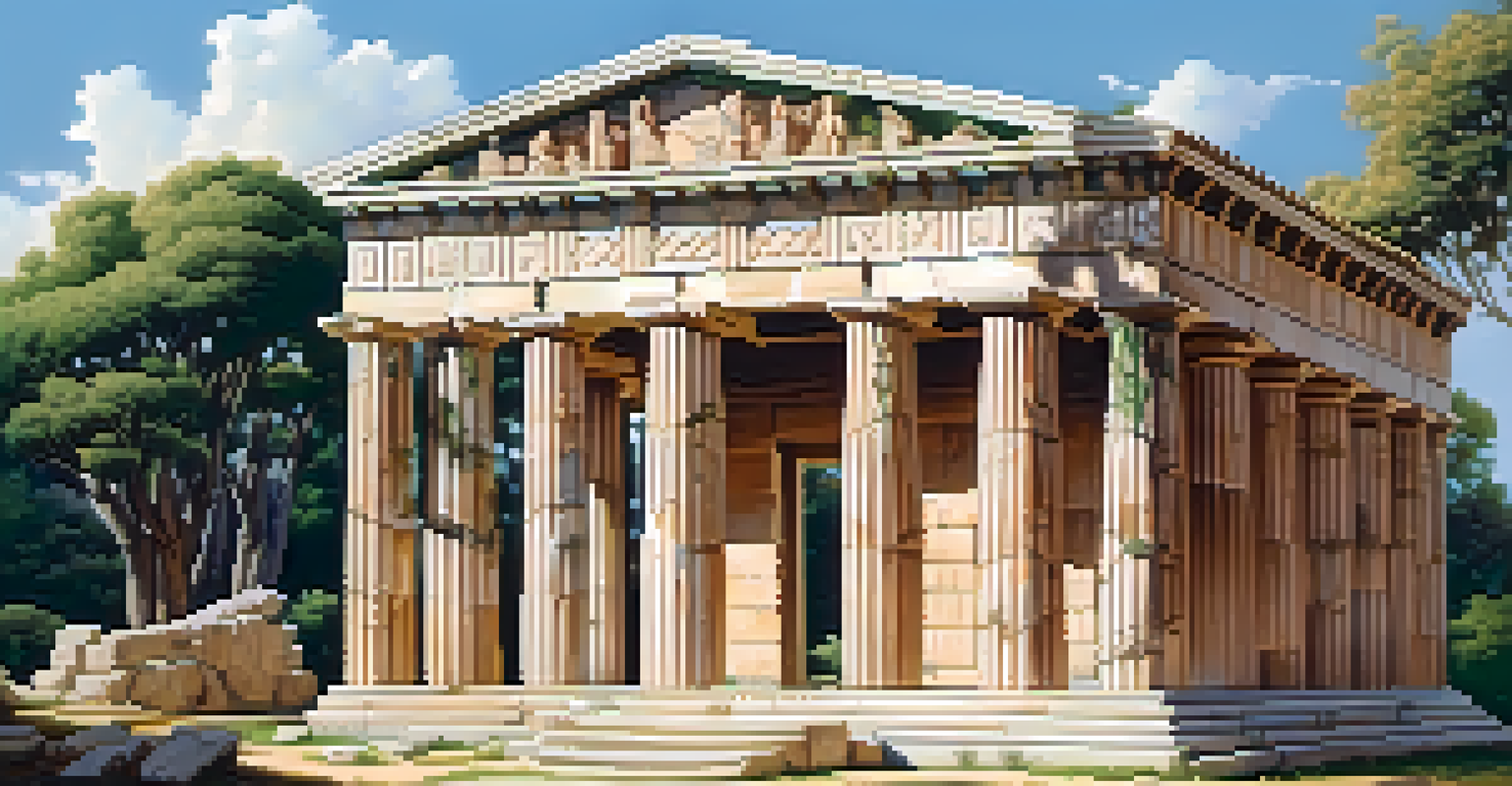Greek Architectural Carvings: A Study of Aesthetic Values

The Origins of Greek Architectural Carvings
Greek architectural carvings date back to ancient times, reflecting the values and beliefs of the society. These carvings emerged during the Archaic period and evolved through the Classical and Hellenistic eras. They were often used to decorate temples, public buildings, and monuments, serving both aesthetic and functional purposes.
Architecture is the art of how to waste space.
Incorporating themes from mythology and daily life, these carvings provided insight into the cultural context of the time. For instance, the intricate friezes on the Parthenon depict scenes of battles and religious ceremonies, showcasing the civilization's rich storytelling tradition. Each carving not only added beauty but also conveyed important narratives that resonated with the community.
As we study these origins, we can appreciate how the artistry of these carvings set the foundation for Western architecture. The techniques and styles developed by ancient Greek artisans continue to influence modern design, illustrating a timeless pursuit of beauty and meaning in art.
Key Elements of Greek Architectural Carvings
Greek architectural carvings are characterized by distinct elements like reliefs, friezes, and pediments. Reliefs are sculpted images that protrude from a flat surface, creating a dynamic visual effect. Friezes, often located just below the roofline, showcase continuous scenes that tell a story, while pediments are the triangular spaces above doors that frequently feature mythological themes.

These elements serve not just for decoration but also for conveying deeper meanings. For example, the use of specific motifs like the acanthus leaf signifies life and fertility, reflecting the values held dear by the Greeks. Such choices in design reveal an intricate connection between form and function, where each carving contributes to the overall narrative of the structure.
Greek Carvings Reflect Cultural Values
Greek architectural carvings embody the society's values, beliefs, and storytelling traditions through intricate designs and symbolism.
Understanding these key elements helps us appreciate the meticulous craftsmanship involved in Greek architecture. Every detail, from the curvature of a leaf to the positioning of a figure, was deliberately chosen to enhance both the aesthetic appeal and the storytelling aspect of the building.
Symbolism in Greek Carvings
Symbolism plays a crucial role in Greek architectural carvings, as they often represent broader themes and ideals. For instance, depictions of gods and goddesses are common, intended to invoke their favor and protection over the structures. The presence of figures like Athena on the Parthenon reinforces the city's dedication to wisdom and warfare, embodying the values of the Athenian people.
Art is the most beautiful of all lies.
Furthermore, everyday scenes of agriculture, labor, and celebration illustrate the connection between the divine and the mundane. These carvings serve as reminders of the importance of community, work, and the natural world in Greek life. Such symbols were not merely decorative; they were integral to the identity and beliefs of the society.
By analyzing the symbolism in these carvings, we gain insight into the priorities and worldview of ancient Greeks. The layers of meaning embedded in the artwork invite us to reflect on how art can express complex ideas and emotions, making it timeless and relevant even today.
Techniques Used in Greek Carving
The techniques employed in Greek carvings are a testament to the skill and creativity of ancient artisans. They primarily used tools like chisels and hammers, meticulously shaping stone to achieve a desired level of detail. The mastery of techniques such as contrapposto—where figures are depicted in a relaxed position—allowed for more dynamic and lifelike representations.
Additionally, the Greeks utilized various materials, including marble and limestone, each chosen for its unique properties. Marble, prized for its durability and beauty, was often used for monumental structures, while limestone was more common for everyday buildings. Understanding these choices helps us appreciate the practical aspects of artistic expression.
Techniques Showcase Artisan Skill
The mastery of carving techniques and material choices highlights the creativity and craftsmanship of ancient Greek artisans.
These techniques not only highlight the artisans' craftsmanship but also reflect the philosophical ideas of harmony and proportion that the Greeks valued. The balance achieved in their carvings is a visual representation of their pursuit of beauty in both art and life.
The Influence of Greek Carvings on Art and Architecture
Greek architectural carvings have left a lasting legacy, influencing countless generations of artists and architects. The principles of proportion, symmetry, and harmony found in these works have shaped the foundations of Western art. From the Renaissance to modern architecture, the reverence for Greek styles persists, echoing their aesthetic values through the ages.
For instance, the neoclassical movement in the 18th and 19th centuries directly drew inspiration from Greek designs, seeking to emulate their grandeur and elegance. Structures like the U.S. Capitol Building showcase columns and pediments reminiscent of ancient temples, reinforcing the ideals of democracy and civic virtue. This influence extends beyond architecture into sculpture and painting, where Greek motifs and themes continue to resonate.
By examining this influence, we see how Greek architectural carvings have become a universal language of beauty and ideals. They remind us that art transcends time, connecting us with the thoughts and aspirations of those who came before us.
Preservation Challenges of Greek Carvings
Despite their historical significance, Greek architectural carvings face numerous preservation challenges. Natural weathering, pollution, and human activity have taken a toll on these ancient artworks, leading to deterioration over time. For example, the Parthenon has suffered from both environmental factors and misguided restoration efforts, altering its original form.
Efforts to preserve these carvings require a delicate balance between conservation and restoration. Experts must carefully assess the condition of each piece, deciding whether to repair or stabilize them while maintaining authenticity. This meticulous work highlights the importance of preserving cultural heritage for future generations to appreciate and learn from.
Preservation Ensures Cultural Legacy
Addressing preservation challenges is crucial for maintaining the integrity and significance of Greek architectural carvings for future generations.
Addressing these challenges not only safeguards the physical carvings but also protects the stories and values they embody. By investing in preservation, we ensure that the beauty and significance of Greek architectural carvings continue to inspire and educate.
The Future of Greek Architectural Carvings
Looking ahead, the future of Greek architectural carvings remains promising yet complex. Advances in technology, such as 3D scanning and digital restoration, offer new ways to document and preserve these artworks. These innovations can help create virtual models that allow for greater accessibility and understanding of the carvings, enabling a global audience to appreciate their beauty.
Moreover, educational initiatives focusing on Greek art and architecture can foster a deeper appreciation among younger generations. By incorporating these themes into school curricula and community programs, we can spark interest in the history and significance of Greek carvings. This engagement can cultivate a sense of stewardship for cultural heritage.

Ultimately, the future of Greek architectural carvings lies in our collective commitment to preserving and celebrating their legacy. As we continue to explore and appreciate these masterpieces, we contribute to a shared cultural narrative that enriches our understanding of the past and inspires creativity in the present.